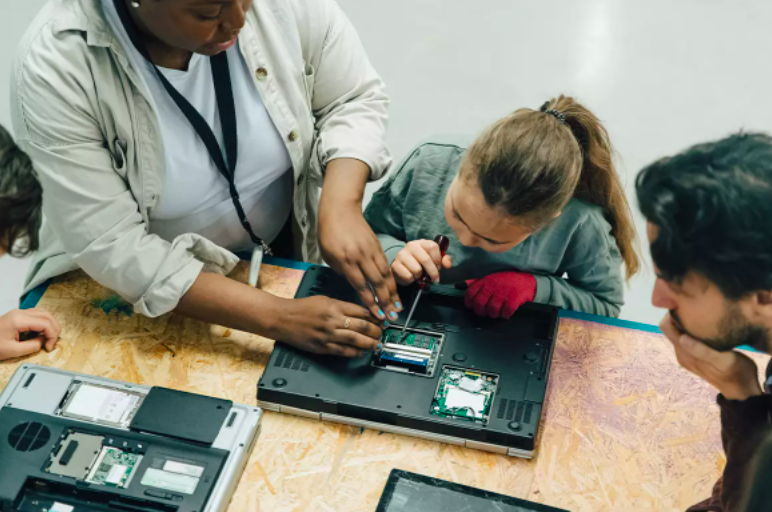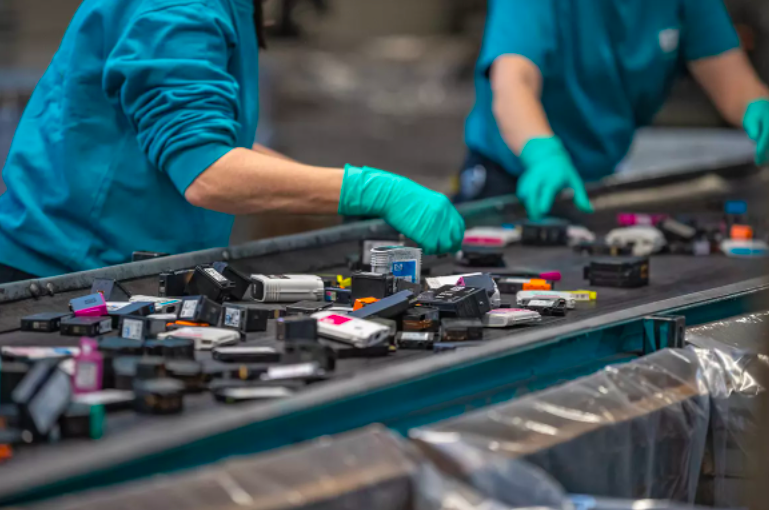How To Recycle Almost Any Household Electronic Device
Ideas for donating, recycling, or even repurposing your old devices, gadgets, and appliances.
The average American household now has about 25 connected devices, including laptops, smartphones, tablets, video streaming devices, fitness trackers, gaming consoles, and voice assistants. Add to that all of the other electronic must-haves around the house, such as Instant Pots, air fryers, kids’ toys, and air purifiers, along with standards like refrigerators, toasters, TVs, and stereos, and the picture is clear: Families today have more electronic devices in their homes than ever before, which means they’re also creating an unprecedented amount of electronic waste.
When these devices and appliances break or get replaced, they often end up in the trash. Globally, electronic waste in landfills is a major and escalating problem, with a record-setting 53.6 million metric tons generated in 2019, up 20% from 2010. That number is likely to reach 74 million metric tons by 2030, according to the Global E-Waste Monitor, a collaborative of organizations including the United Nations and the World Health Organization.
“We live in a world where consumers are constantly changing their electronic devices for higher quality products,” says Patrick Gibbs, HP’s recycling manager for North America. “We need to be responsible about what’s happening to the old material.”
Devices tossed in a landfill can impact environmental and human health by releasing toxins like lead, mercury, chloride, and cadmium into the soil and polluting ground water. Expectant mothers exposed to toxic e-waste can experience stillbirth or premature births, according to the World Health Organization, while children can experience breathing problems or increased risk of chronic diseases later in life. Fortunately, as a consumer, you have a number of options to help prevent that, including donating, recycling, and even repurposing your old devices.
If you have a drawer of old smartphones, a pile of outdated laptops, or even an old toaster at home that you just don’t know what to do with, here are some ways to safely recycle and reuse.
Donate devices for someone else to use
A used cell phone, laptop, or other smart device can be a lifeline for a newly arrived refugee looking for housing and work, someone who’s moved into a domestic violence shelter, or a child without access to their own digital devices at school or home.
Donating these types of devices is more pressing these days, says Sally Tran, marketing and events coordinator with the Canada-based Electronic Recycling Association (ERA), since the high cost of goods combined with production and shipping delays means fewer companies are retiring older devices and donating them to organizations like hers.
“We encourage people to think about the life cycle of the phone,” Tran says, “Instead of sending it to landfill or having it sit in a drawer, give it to somebody that needs it. It may be old to you, but it’s new to someone else.”
Before donating a device, be sure to transfer and delete any personal information to protect your privacy. In the US and Canada, the ERA has warehouses for device drop off, a mail-in program, or you can schedule a pickup, and they do their own data wipe after receiving a device.
Computers with Causes refurbishes and upgrades donated laptops, tablets, and other gadgets before donating them to youth centers, returning military members, and schools. World Computer Exchange accepts used smartphones, digital projectors, and webcams, which it donates to communities and schools in places like Puerto Rico and Africa. Recono.me collects, repairs, and redeploys devices to schools and consumers in the UK where, for every phone in use, four sit unused. Big Sky Recycling recycles smartphones and donates to environmental, social, and veterans causes.
You may even find someone in your own neighborhood who would love a “new-to-them” device that you no longer need. One option is the “buy nothing” groups on Facebook, where you can get items from toasters to power tools for free from your neighbors. Freecycle.org also helps people give and get blenders, microwaves, fridges and other unwanted products in their local communities for no cost.
“People’s intuition is to take things to a thrift shop,” says Freecycle founder and executive director Deron Beal. “But the majority of items don’t sell and are thrown away. "Giving something to someone else in your community is a lovely moment that feels good, and you’re helping the planet."
Some cities also have toy libraries you can donate to, where kids can check out gently used toys, games, puzzles, and costumes. Gaming systems can often be donated to local childrens’ hospitals or to nonprofits such as Gamers Outreach and Charity Gaming.
Find a manufacturer or retailer’s take-back program
If you have a device like a radio, stereo, or a printer you no longer want or need, check with the product manufacturer to see if they have a recycling program of their own you can access.
HP, for example, works with recycling partners such as Homeboy Recycling in Los Angeles to recover recyclable materials from HP devices collected from businesses and consumers while creating job opportunities in local communities. Consumers can drop off out-of-use devices at HP partners like Best Buy, and businesses with numerous devices to recycle can request on-site pickup through HP’s Planet Partners program, which collects devices, as well as ink and toner cartridges, in 76 countries and territories worldwide.
Big box stores like Best Buy often have their own recycling programs and accept numerous brands and types of devices and appliances. Best Buy has a home pick-up program for recycling everything from laptops to washing machines, Staples accepts and recycles items like shredders, keyboards, and modems, and Walmart lets consumers trade in gadgets like cell phones and Bluetooth speakers for gift cards.
Look for a responsible recycling program
If you can’t recycle your item through the manufacturer, there are plenty of nonprofits and other programs that will help you recycle it and keep it out of a landfill.
Smartphone Recycling makes it easy to send phones in for recycling, including damaged and locked devices. The organization reimburses for smartphones and tablets, depending on their condition. Thousands of businesses, schools, and colleges have earned money through its zero-landfill recycling program. If your device does still work, you can also choose to donate it to support the group’s nonprofit partner Operation Gratitude.
The US Environmental Protection Agency (EPA) offers a directory of options for responsible device recycling, and around 8.9 million refrigerated appliances have been recycled through the EPA’s own Responsible Appliance Disposal (RAD) program, which includes partners in local communities across the country.
HP Planet Partners collects used products including ink and toner cartridges and batteries from notebooks and smartphones for recycling as well as reuse in new printers and cartridges.
Many cities have their own recycling center, or you can find large nonprofits like Habitat for Humanity ReStores or Big Reuse in Brooklyn, which take items including electronics, homegoods and hardware. To find a variety of recycling options in your area, you can also enter your zip code onto Earth911’s recycling database website.
“If you just spend a few seconds to search your ZIP code for local options to recycle household waste, you’ll be stunned at the available resources,” says Gibbs.
Try repairing or upcycling
Sometimes an older device can be as good as new after a repair. Many products have been tricky to fix, however, because they can’t be opened without destroying them or there are no third-party options for buying parts, making repairs too pricey.
Product fixes are becoming more common lately, however, after a so-called Right to Repair executive order that nudges the Federal Trade Commission to make third-party product repair easier.
Another avenue for repairs is the Consumer Technology Association’s Greener Gadgets initiative, which connects consumers with a manufacturer’s repair network made up of properly trained and vetted professionals who can fix specific devices.
You can also transform and repurpose your device in ways that are practical and fun. For example, the Alarm Clock for Me app turns old smartphones into clocks, while the Alfred app can make your phone a security camera. Other inventive ideas include turning an old computer monitor into a cat bed, a VHS machine into a toaster, phone cases into coasters or even keyboard keys into pendant jewelry.
Whatever you choose, whether it’s donating, recycling, or repurposing, taking steps to keep your electronics out of a landfill has impacts beyond your own environmental footprint.
“Reuse and recycling are hugely empowering,” says Beal. “You’re not just keeping an item out of the landfill, you’re also keeping raw materials from being used to produce a new item.”



